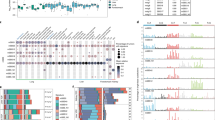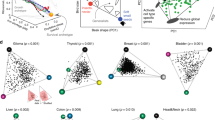Abstract
Using several populations (ethnic groups) as an example and by means of the statistical analysis of the data available in literature, we theoretically justified the possibility of metabolic “in vivo designing” of tumors in bronchi and lungs, larynx, brain and nervous system, mammary gland, bladder, and liver at the human organism and population levels under conditions of genetically-determined metabolic status of these populations, i.e., the possibility of population-dependent carcinogenesis in the above organs. A comparison of the populations showed that the incidences of cancer (a) in each of the six organs was dissimilar at the different rate of one or other metabolic phenotype and (b) in each of the three organs, larynx, mammary gland, and bladder, it was similar at the same rate of one or other metabolic phenotypes. No population-dependent carcinogenesis in all six or several other organs was observed in the compared populations in the following cases: different cancer incidence in each of six organs at the same rate of one or other metabolic phenotype; similar cancer incidences in each of four organs—larynx, brain and nervous system, mammary gland, and bladder—at a different rate of one or other metabolic phenotypes; and different cancer incidence in organs, other than the mammary gland and liver, in males and females, irrespective of the rate of metabolic phenotype. These data on the incidence rate included no data on chemical carcinogenesis. To prove the population-dependent carcinogenesis in the above-mentioned and other organs, it is necessary to theoretically study and identify the molecular structures responsible for carcinogenesis in tumor cells obtained from representatives of different populations with certain metabolic phenotypes.
Similar content being viewed by others
REFERENCES
Piruzyan, L.A. and Mikailovskii, E.M., Metabolic “In vivo Designing” of Tumors at the Levels of an Organism and Population under Conditions of Individual Genetic Predisposition: Communication II, Fiziol. Chel., 2002, vol. 28, no. 1, p. 101.
Piruzyan L.A. and Mikailovskii, E.M., Metabolic “In vivo Designing” of Tumors at the Levels of an Organism and Population under Conditions of Individual Genetic Predisposition: Communication I, Fiziol. Chel., 2001, vol. 27, no. 3, p. 113.
Cancer Incidence in Five Continents, Lyon: IARC, 1992, vol. VI, pp. 252, 256, 260, 264, 272, 277, 287, 292, 296, 301, 310, 318, 326, 354, 362, 370, 390, 394, 395, 402, 454, 774, 778, 782, 786, 790, 794, 798, 802, 871, 930, 931, 940, 956, 957, 976, 977, 982, 983.
Hetzel, M.R., Law, M., Keal, E.E., et al., Is there a Genetic Component in Bronchial Carcinoma in Smokers, Thorax, 1980, vol. 35, no. 9, p. 709.
Bushma, M.I., Andreev, V.P., and Bushma, T.V., Biochemical Risk Factors of Cancer of Lungs, Vopr. Onkol., 1999, vol. 45, no. 5, p. 572.
Goedde, H.W., Ethnic Differences in Reactions to Drugs and Other Xenobiotics. Outlook of a Geneticist, in Ethnic Differences in Reactions to Drugs and Xenobiotics, New-York: Liss, 1986, p. 9.
Kellermann, G., Shaw, C.A., and Luyten-Kellermann, M., Aryl Hydrocarbon Hydroxylase Inducibility and Bronchogenic Carcinoma, New Engl. J. Med., 1973, vol. 289, no. 18, p. 934.
Gahmberg, C.G., Sekki, A., Kosunen, T.I., et al., Induction of Aryl Hydrocarbon Hydroxylase Activity and Pulmonary Carcinoma, Int. J. Cancer, 1979, vol. 23, p. 302.
Coles, B. and Ketterer, B., The Role of Glutathione and Glutathione Transferases in Chemical Cancerogenesis, CRC Crit. Rev. Biochem. Molec. Biol., 1990, vol. 25, no. 1, p. 47.
Seidegard, J., Pero, R.W., Markowitz, M.M., et al., Isoenzyme(s) of Glutathione Transferase (Class Mu) as a Marker for the Susceptibility to Lung Cancer: a Follow up Study, Carcinogenesis, 1990, vol. 11, no. 1, p. 33.
Warholm, M., Guthenberg, C., and Mannervik, B., Molecular and Catalytic Properties of Glutathione Transferase μ from Human Liver. An Enzyme Efficiently Conjugating Epoxides, Biochemistry, 1983, vol. 22, no. 15, p. 3610.
Hein, D.W., Acetylator Genotype and Arylamine-Induced Carcinogenesis, Biochim. Biophys. Acta, 1988, vol. 948, no. 1, p. 37.
Gonzalez, F.J., Molecular Genetics of the P-450 Super family, Pharmacol. Ther., 1990, vol. 45, no. 1, p. 1.
Elexpuru-Camiruaga, J., Buxton, N., Kanadula, V., et al., Susceptibility to Astrocytoma and Meningioma: Influence of Allelism at Glutathione S-Transferase (GSTT! and GSTM1) and Cytochrome P-450 (CYP 2D6) Loci, Cancer Res., 1995, vol. 55, no. 19, p. 4237.
Bulovskaya, L.N., Krupkin, R.G., Bochina, T.A., et al., Acetylator Phenotype in Patients with Breast Cancer, Oncology, 1978, vol. 35, no. 4, p. 186.
Evans, D.A., Acetylation, in Ethnic Differences in Reactions to Drugs and Xenobiotics, New York: Alan R. Liss, 1986, p. 189.
Lower, G.M., N-Acetyltransferase Phenotype and Risk in Industrial Urinary Bladder Cancer: Approaches to High Group, in Toxicological and Occupational Medicine, Elsevier: Amsterdam, 1979, p. 209.
Polzik, E.V., Katsnel'son, B.A., Yakusheva, M.Yu., et al., Search for Markers of Genetic Predisposition to Malignant Tumors, Vopr. Onkol., 1993, vol. 39, no. 1-3, p. 32.
Kirlin, W.G., Trinidad, A., Yerokun, T., et al., Polymorphic Expression of Acetyl Coenzyme A-Depended Arylamine N-Acetyltransferase and Acetyl Coenzyme A-Depended O-Acetyltransferase Mediated Activation of N-Hydroxyarylamines by Human Bladder Cytosol, Cancer Res., 1989, vol. 49, no. 9, p. 2448.
Cartwright, R.A., Rogers, H.U., Barham-Hall, D., et al., Role of N-Acetyltransferase Phenotypes in Bladder Carcinogenesis: a Pharmacogenetic Epidemiological Approach to Bladder Cancer, Lancet, 1982, vol. 2, no. 8303, p. 842.
Omeno, G.S., Susceptibility to Occupational and Environmental Exposures to Chemicals, in Ethnic Differences in Reactions to Drugs and Xenobiotics, New York: Alan R. Liss, 1986, p. 527.
Karakaya, A.E., Cok, I., Sardas, S., et al., N-Acetyltransferase Phenotype of Patients with Bladder Cancer, Human Toxicol., 1986, vol. 5, p. 333.
Idle, J.R., Mahgoub, A., Sloan, T.P., et al., Some Observations on the Oxidation Phenotype Status of Nigerian Patients Presenting with Cancer, Cancer Letters, 1981, vol. 11, no. 4, p. 331.
Watanabe, M., Nipp. Rincho, 1996, vol. 54, no. 8, p. 2261, in Ref. Zh., seriay: Fiz.-Khim. Biol., 1999, Ref. no. 99. 10-04 D 5. 217.
Windmill, K.F., McKinnon, R.A., Zhu, X., et al., The Role of Xenobiotic Metabolic Enzymes in Arylamine Toxicity and Carcinogenesis: Functional and Localization Studies, Mutat. Res., 1997, vol. 376, no. 1-2, p. 153.
Pezzella, M., Single Gene Neutralizes Toxic Chemicals, Avoids Cancer, in Ref. Zh., seriya: Biol., 2000, Ref. No. 00.03-04N 1.350.
Savilov, E.D., Mamontova, L.M., Astaf'ev, V.A., and Ivanova, L.V., Primenenie statisticheskikh metodov v epidemiologicheskom analize (Application of Statistical Methods in Epidemiological Analysis), Novosibirsk: Nauka, 1993, p. 14, 26, 127.
Bessmertnyi, B.S. and Tkacheva, M.N., Statisticheskie metody v epidemiologii (Statistical Methods in Epidemiology), Moscow: Medgiz, 1961, p. 44.
Author information
Authors and Affiliations
Rights and permissions
About this article
Cite this article
Piruzyan, L.A., Mikhailovskii, E.M. Metabolic “in-vivo Designing” of Tumors at the Organism and Population Levels under Conditions of Individual Genetic Predisposition. Communication III. Human Physiology 28, 600–608 (2002). https://doi.org/10.1023/A:1020239104728
Issue Date:
DOI: https://doi.org/10.1023/A:1020239104728




